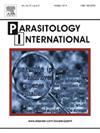A scanning electron microscopy based survey of the impact of infestation by parasitic freshwater mussel glochidia upon the gill morphology of two species of salmonid fish
IF 1.9
4区 医学
Q3 PARASITOLOGY
引用次数: 0
Abstract
Unionid mussels are a distinct order possessing a parasitic life history stage known as a glochidium that generally infests the gills of fish. Upon contacting the host tissue, the glochidium ‘bites’ down causing minor surface trauma but leaving most structural tissue unharmed. Host tissue immediately reacts and encompasses the larval mussel in a cyst where, if able to survive, the glochidia will develop and ultimately excyst as free-living mussels; in the case of the freshwater pearl mussel (Margaritifera margaritifera) adults can live in the sediment for up to 200+ years. While many histological studies have detailed both the encystment process and larval development with a fair degree of detail, few have utilized scanning electron microscopy to add further prospective. Few have investigated the effects of juvenile mussel excystment on host tissue. The freshwater pearl mussel is the longest encysting unionid mussel, remaining on their hosts for close to a year. Here, we investigate three stages of freshwater pearl mussel glochidia development on two host salmonid species (Salmo trutta and S. salar). Our survey supports previously published results and suggests that juvenile mussel excystment causes significantly more harm to host tissue than initial encystment. We provide a large library of images as supplements to this survey for both researchers and educators to use as references, either for educational purposes or out of general interest.

基于扫描电子显微镜的两种鲑科鱼类寄生淡水贻贝侵染对鳃形态影响的研究
联合贻贝是一种独特的目,具有寄生生活史阶段,称为舌虫,通常寄生于鱼类的鳃。一旦接触到宿主组织,舌虫就会“咬”下去,造成轻微的表面创伤,但大多数结构组织不会受到伤害。宿主组织立即做出反应,将幼虫贻贝包裹在一个囊肿中,如果能够存活,glochidia将发育并最终成为自由生活的贻贝;淡水珍珠贻贝(Margaritifera Margaritifera)的成虫可以在沉积物中生活长达200多年。虽然许多组织学研究都详细说明了囊化过程和幼虫发育的相当详细的程度,很少有利用扫描电子显微镜来增加进一步的前景。很少有人研究幼年贻贝排泄物对宿主组织的影响。淡水珍珠贻贝是最长的结壳贻贝,在它们的宿主上停留近一年。本文研究了淡水珍珠贻贝在两种寄主鲑(Salmo trutta和S. salar)上发育的三个阶段。我们的调查支持先前发表的结果,并表明幼年贻贝的囊泡对宿主组织的伤害明显大于初始囊泡。我们提供了一个大型图片库,作为本调查的补充,供研究人员和教育工作者用作参考,无论是出于教育目的还是出于一般兴趣。
本文章由计算机程序翻译,如有差异,请以英文原文为准。
求助全文
约1分钟内获得全文
求助全文
来源期刊

Parasitology International
医学-寄生虫学
CiteScore
4.00
自引率
10.50%
发文量
140
审稿时长
61 days
期刊介绍:
Parasitology International provides a medium for rapid, carefully reviewed publications in the field of human and animal parasitology. Original papers, rapid communications, and original case reports from all geographical areas and covering all parasitological disciplines, including structure, immunology, cell biology, biochemistry, molecular biology, and systematics, may be submitted. Reviews on recent developments are invited regularly, but suggestions in this respect are welcome. Letters to the Editor commenting on any aspect of the Journal are also welcome.
 求助内容:
求助内容: 应助结果提醒方式:
应助结果提醒方式:


